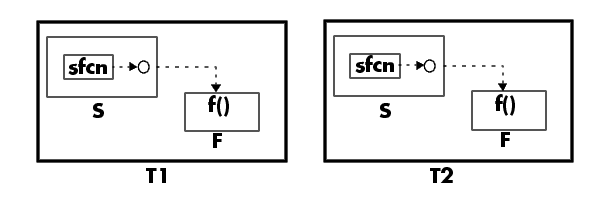

| Target Language Compiler |   |
Code Data Structure Concepts
In general, a block diagram is encoded using one or more of the following model data structures:
The model data structures are layered out according to the model hierarchy and the length is limited to at most 7 characters to allow us to stay within the 31 identifier character limit.
The layout includes function-call systems that reside in a parent system of their caller. For example, in the following model, subsystems T1 and T2 are structurally the same:

typedef struct rtB_S_tag { <block outputs in S> } rtB_S; typedef struct rtB_F_tag { <block outputs in F> } rtB_F; typedef struct rtB_T_tag { <regular (non system) block outputs in T> rtB_S s; rtB_F f; } rtB_T; typedef struct rtB { <regular (non system) block outputs in root> rtB_T t1; rtB_T t2; }
This nesting of the block I/O data structure concept is applied to the other model structures (e.g., DWork). For the case of inline parameters off, the generated code will look roughly like:
F(f_input_signals, rtB_F *rtB, rtP_F *rtP) { ... } S(s_input_signals , rtB_S *rtB , rtP_S *rtP, s_input_signals_for_F, rtB_F *rtB_F1, rtP_F *rtP_F1) { ... F(f_input_signals, rtB_F1, rtP_F1) ... } T(t_input_signals, rtB_T *rtB, rtP_T *rtP) { ... S(s_input_signals, &rtB->s, &rtP->s, s_input_signals_for_F, &rtB->f, &rtP->f) ... } MdlOutputs() { ... T(t1_input_signals, &rtB.t1, &rtP.t1); // outputs are passed via rtB.t1 ... T(t2_input_signals, &rtB.t2, &rtP.t2); // outputs are passed via rtB.t2 ... }
 | General model.rtw Concepts | Inline Parameters On Code Structure |  |